Speech The Development and Resilience of Financial Systems in Asia

Philip Lowe
[1]
Assistant Governor (Economic)
Remarks at In the Zone Conference, University of Western Australia
Perth –
In my remarks this morning, I would like to focus on three broad issues.
The first of these is the way that the integration of Asian financial systems into the global financial system has taken place.
The second is the considerable resilience of Asian financial systems over the past 18 months.
And the third is some general lessons that one might draw from the recent experience.
Financial System Integration
As is well known, the economies of Asia are highly integrated into the global trading system for goods and services. For many of the economies of the region, the ratios of exports and imports to GDP are significantly higher than for most of the developed economies (Graph 1). In contrast, financial systems in Asia are not as highly integrated into the global financial system.
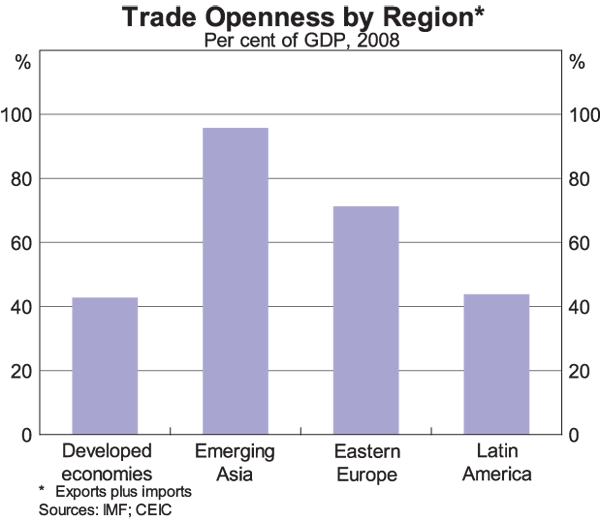
There are two aspects of this integration that I would like to highlight.
The first relates to the scale of cross-border capital flows. In the developed economies, there are typically very large private gross cross-border capital flows, with for example, German residents investing significant amounts of money in US assets and US residents investing significant amounts of money in German assets. Over the past decade, this cross-border flow of capital has averaged around 15 per cent of GDP a year, although it fell a lot recently as ‘home bias’ strongly reasserted itself (Graph 2). In contrast, the two-way flow of capital is much smaller in Asia, with gross private capital flows averaging just 2 per cent of GDP over the past decade.
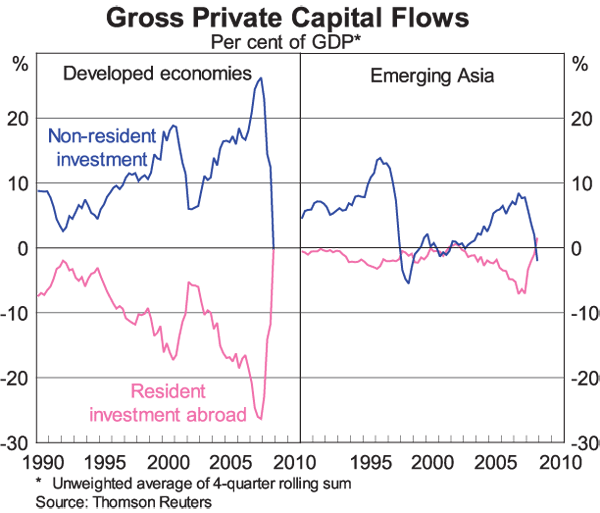
The second aspect of Asian financial integration is the role played by public-sector entities. For some years now, saving ratios in Asia have been considerably higher than investment ratios (Graph 3). This is particularly the case in China. These ‘excess savings’ have, by necessity, been channelled to the rest of the world. However, this has not occurred by the private sector in Asia buying foreign assets, but rather by the public sector, in the form of the central bank buying foreign assets. As a result, foreign exchange reserves held by central banks in Asia have increased markedly, from around US$½ trillion a decade ago to around US$4 trillion today (Graph 4).
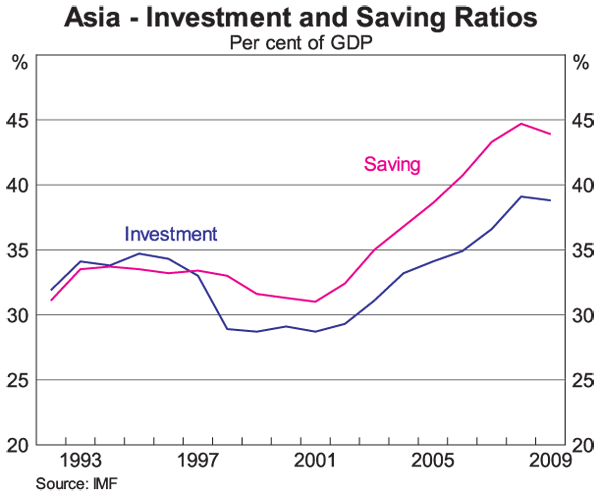
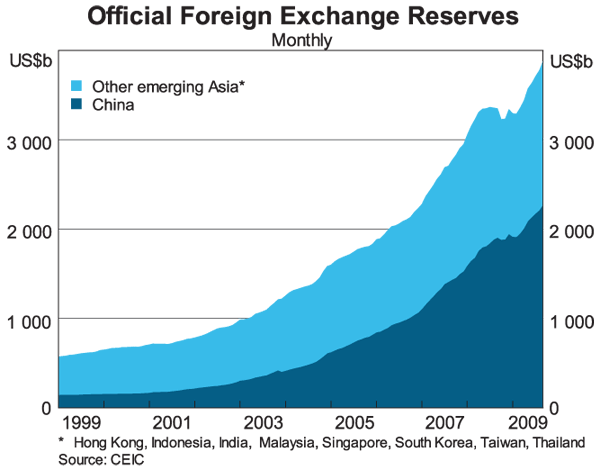
This model of financial integration – with relatively small gross capital flows and the central bank playing a key role – has had implications for the development of domestic financial markets in Asia, with these markets playing a less important role in the allocation of capital than in some other countries. Notwithstanding this, since the Asian crisis of the late 1990s, significant efforts have been made to deepen financial markets in the region. The share of Asian currencies (excluding the yen) in global foreign exchange turnover has doubled since 1998 – although it remains small – and liquidity in private and public debt markets has improved. In a number of countries there has also been an improvement in the infrastructure supporting financial markets.
Looking forward, the strong economic performance seen in Asia should help build the basis for further financial market development. Nothing hurts the growth of financial markets more than concerns about counterparty risk, and high country risk adds to these concerns. The recent relatively good performance of a number of countries in the region should give market participants additional confidence in the resilience of the Asian economies and thus confidence in the strength of counterparties in the region. One illustration of the general improvement in the fundamentals can be seen in the rise in the average quality of sovereign credit ratings in Asia over recent years (Graph 5).
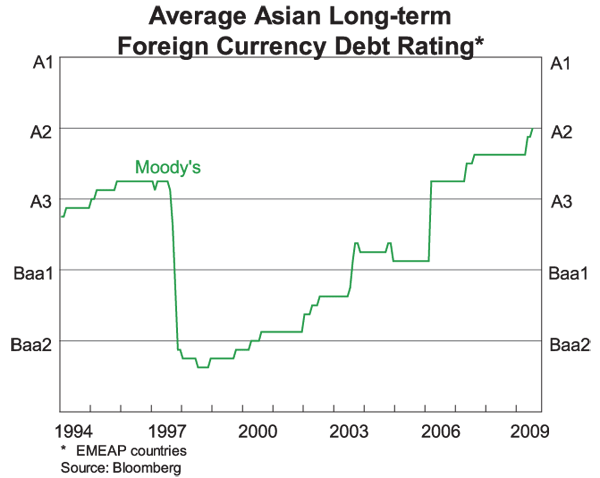
Financial System Resilience
I would like to now turn to the second issue – the resilience of Asian financial systems.
It has become common to talk of recent events as the ‘GFC’ – the global financial crisis. This is really a misnomer though. It has not been a crisis in all financial systems around the globe. Rather, it has been a crisis in the financial systems of many of the advanced countries of the North Atlantic. To be sure, this crisis has had very large ramifications for the global economy – including the economies of Asia – but we have not seen a crisis in the financial systems of Asia.
There have not been collapses of large financial institutions in Asia and banks have not needed to be rescued by governments. And while the stock prices of banks in the region fell sharply late last year – as they did around the world – this relative resilience has meant that the loss of market value in the banking sector has been less in Asia than in most of the advanced economies (Graph 6).
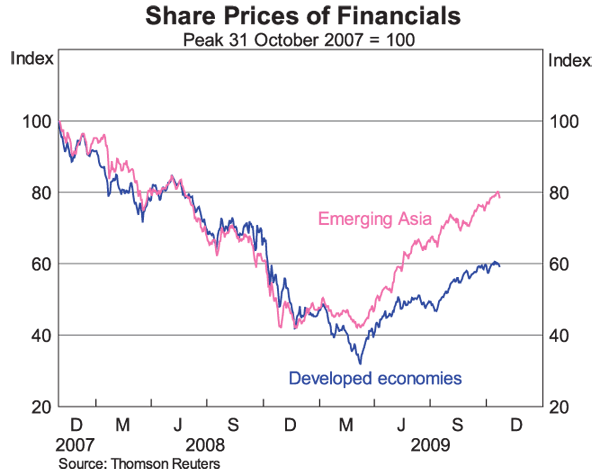
An obvious question to ask is why Asian financial systems have been so resilient, especially given that, just like in the late 1990s – when there was a financial crisis in the region – there was a sharp reversal of bank capital flows into Asia late last year (Graph 7).
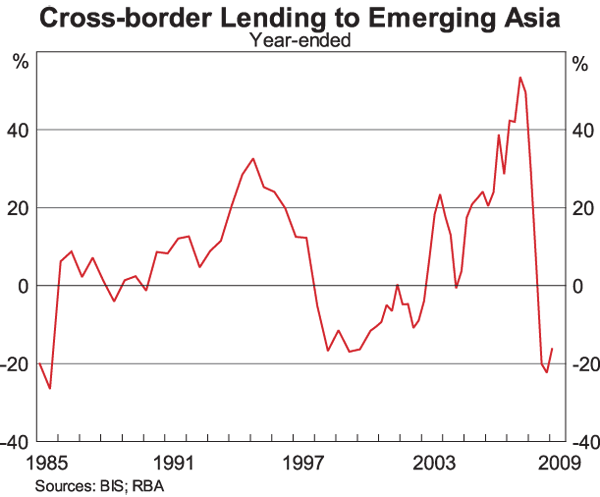
One clear difference between then and now is that on this occasion the sharp fall in bank inflows into Asia was caused by a crisis of confidence in the lending banks – particularly in Europe – not in the borrowing banks as it was during the late 1990s episode. While the banks in Asia had to adjust to the effective closure of international capital markets for a time, there was not a loss of confidence in domestic counterparties, and the banks of the region have been able to continue performing their critically important role of intermediating between borrowers and lenders. The result has been that credit to the private sector has continued to grow at a reasonable pace in most countries of the region (Graph 8).
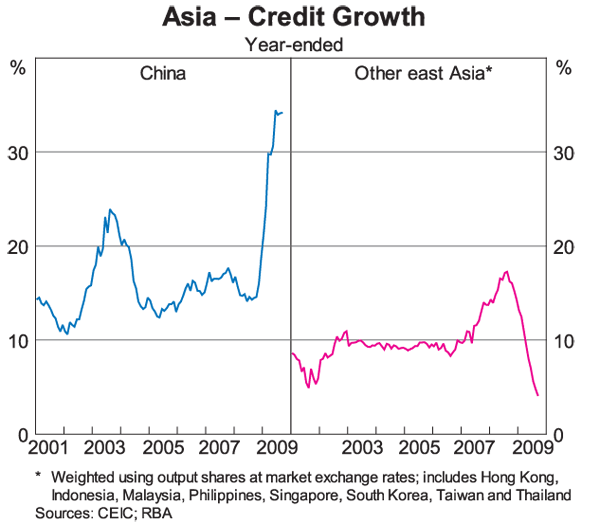
Part of the explanation for this resilience can be found in the factors that I mentioned a few moments ago – the way that the integration into the world financial system has occurred and the greater reliance on banks, rather than financial markets.
It is possible – although certainly not inevitable – that if the private sector in Asia had recycled the high savings of the region to the rest of the world, then Asian entities would have ended up holding a significantly larger share of the structured securities that have caused so much trouble elsewhere. The Asian central banks have predominately bought assets of relatively high credit quality, and even if mark-to-market losses had been incurred, they would not have threatened the viability of these institutions.
In addition, because of the more traditional nature of the assets on the balance sheets of the region's private banks, most banks did not have to record large mark-to-market losses as risk spreads widened dramatically. Instead, provisioning expenses for bad and doubtful debts have continued to be the more important influence on profits. The recovery of many of the economies of the region over recent months, which has been underpinned by stimulatory settings of monetary and fiscal policy, has helped to contain these credit costs.
Another example where the lesser reliance on markets has helped insulate Asian financial systems from developments abroad can be seen in the short-term money market. In a number of countries in the region, turnover in these markets is relatively low at the best of times, and the central bank is a counterparty to many transactions. The fact that the central bank – with its undisputed credit rating for domestic currency transactions – has played this role meant that when risk aversion rose markedly, the same dislocations seen elsewhere did not occur in most countries of the region.
A further factor that has undoubtedly played a role is the large foreign reserves held by central banks, which were built up in response to the crisis of the late 1990s, with many of the countries in the region also running large current account surpluses. There have also been significant improvements in financial regulation since the late 1990s.
In short, the fact that in Asia there is less reliance on financial markets, and more on financial institutions and that central banks have large holdings of foreign reserves, have contributed to the resilience of the region's financial systems.
While this has proved an effective formula, it is worth noting that Australia's financial system – with its greater reliance on markets and its extensive integration into the global financial system – has also been relatively resilient over recent times. Financial institutions in Australia have remained profitable and have high credit ratings. While the Federal Government did have to offer a guarantee of banks' new wholesale funding when global capital markets closed for a time, the severe dislocations evident in the financial systems of North Atlantic countries have not occurred here. Like the banks in Asia, the Australian banks have been able to continue to effectively intermediate between savers and borrowers.
Some Potential Lessons
I would like to now turn briefly to some possible lessons from these experiences.
The first of these is the importance of flexibility.
As we all know, unexpected developments occur from time to time and investors' attitudes to risk can change quickly. Given the inevitable uncertainty in the world and the large swings that can occur in financial markets, having the flexibility to adjust to changing circumstances is critical.
In Australia's case, an important element of this flexibility is a floating exchange rate, which has been a key stabilising influence for almost three decades now. In countries with higher trade shares than Australia's, the benefits from a freely floating exchange rate may be considerably less. More generally, low levels of public debt and a credible monetary policy framework provide policy makers with flexibility to respond quickly and effectively to changing circumstances. Flexible labour and product markets are an important part of the equation. In a number of these dimensions, the Asian economies rate highly, with their flexibility being an important factor underpinning their dynamism of recent decades.
The second lesson is the importance of appropriate regulation.
The recent experience in the North Atlantic financial systems shows what can happen if regulatory arrangements and practices do not keep pace with developments in the financial system. It reminds us all that if countries are to live comfortably with extensive financial markets that are integrated into the global system, then appropriate regulatory arrangements are essential. These arrangements need to cover both banks and markets. But policy makers also need to take a holistic approach – being prepared to respond to growing risks in the system as a whole, rather than risks in just a single institution or a particular market. While this is easier said than done, the task here is not an impossible one.
The third lesson is that resilience in the financial system can be achieved in different ways. There is no one-size-fits-all solution.
There are clearly benefits to be gained from international trade in capital and the development of the financial system. Investors are able to have more diversified portfolios. Households are better able to smooth consumption over time. Financial institutions are likely to be more responsive to the needs of savers and borrowers. And the cost that society pays for financial intermediation is likely to be lower. But globalisation of financial systems and the increased reliance on markets also brings new risks, and these need to be managed carefully.
Countries will clearly differ as to how they view this risk-return trade off, and these views are likely to change over time. A country's history is an important influence, as is its openness to trade, the level of per capita income, and the overall size of the economy. In Australia's case, for example, few people would argue that a return to the highly regulated and less globally integrated financial environment of the 1970s would be the best way to manage these risks.
Whatever approach is chosen, no-one disputes the importance of the overall goal: having a strong and resilient financial system that is able to support the ongoing expansion of the real economy. Over recent times, both Australia and the countries of Asia have had more success here than have many others.
Thank you.
Endnote
I would like to thank Chris Becker, Jon Cheshire and David Orsmond for assistance in the preparation of these remarks. [1]